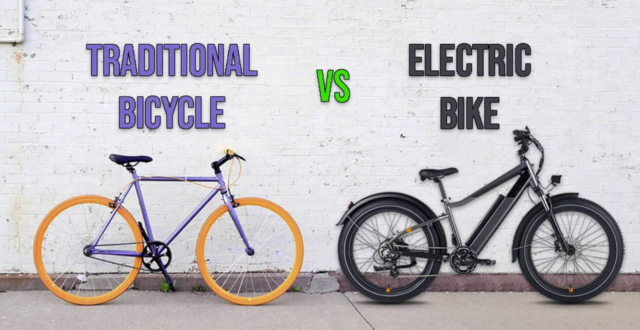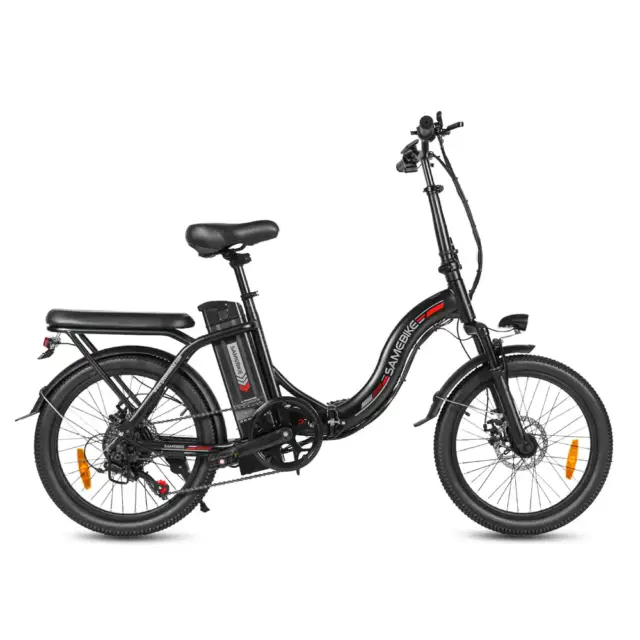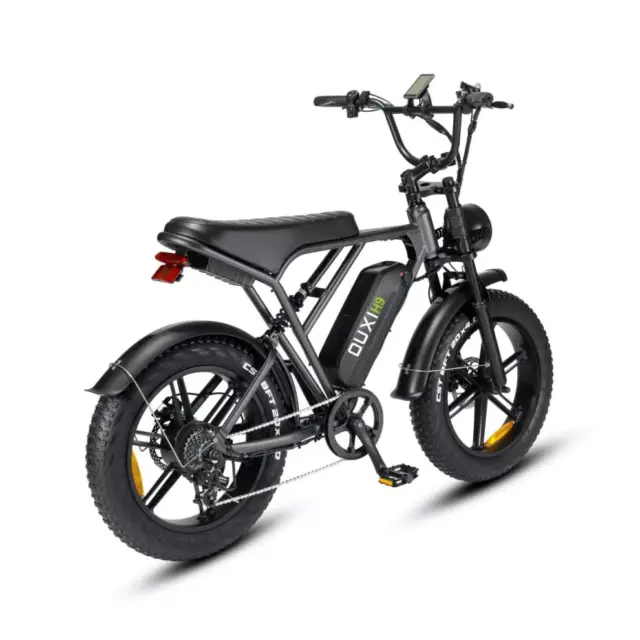
- (+44) 0208 450 3272
- Out Of Hours +44 (0) 7973 266501
- sean@electricbicyclecompany.co.uk
- Mon - Fri: 9:00 - 17:00
- Sat 10.00 - 14.00

At Electric Bicycle Company, a family-run UK business since 2011, we’ve witnessed the e-bike’s rise to prominence. But their story began over a century ago. This article traces the history of the electric bike, from its 1895 origins to the cutting-edge innovations of 2025, highlighting key milestones and the UK’s growing e-bike culture.
[](https://www.bikes.org.uk/the-history-of-electric-bikes/)[](https://electric-bike-store.co.uk/electric-bike-store-news/history-electric-bike/amp/)
The history of the electric bike begins in the late 19th century, when inventors experimented with electrified transport. In 1895, Ogden Bolton Jr., an Ohio inventor, patented a bicycle with a direct-current hub motor mounted on the rear wheel—a design remarkably similar to modern e-bikes. This marked the first documented e-bike patent.
[](https://www.bikes.org.uk/the-history-of-electric-bikes/)
In 1897, Hosea W. Libbey of Boston introduced a prototype with twin electric motors linked to the cranks, powered by two batteries. One battery operated on flat terrain, with the second kicking in for hills, showcasing early innovation in power management. A year later, Mathew J. Steffens patented a rear-wheel e-bike using an external belt drive. These early designs laid the groundwork but were overshadowed by the rise of motor cars.
[](https://www.bikes.org.uk/the-history-of-electric-bikes/)[](https://electric-bike-store.co.uk/electric-bike-store-news/history-electric-bike/amp/)
Despite their ingenuity, these prototypes were heavy, inefficient, and limited by primitive battery technology, making them impractical for widespread use. The electric bike faded into obscurity for decades.
The early 20th century saw little progress in e-bike development. The dominance of internal combustion engines and the high cost of electric motors and batteries stifled innovation. While gas-powered motorized bicycles emerged, electric versions remained niche. A 1930s e-bike prototype, with a 40km range and 2.5km/h top speed, took a day to recharge and failed to gain traction due to its impracticality.
[](https://reightgoodbikes.co.uk/history-electric-bikes/)
During this period, cycling itself evolved, with high-wheelers giving way to safer, chain-driven bicycles. However, electric bikes lacked the technological advancements needed to compete, remaining a curiosity rather than a mainstream option.
The electric bike’s revival began in the late 20th century, driven by environmental concerns and technological breakthroughs. In 1989, Japan’s Yo-Yo customization introduced conversion kits to transform regular bicycles into e-bikes, sparking global interest. These kits made e-bikes accessible and affordable, igniting a new wave of enthusiasm.
[](https://www.bikes.org.uk/the-history-of-electric-bikes/)
In the 1990s, Japanese companies like Yamaha and Panasonic pioneered modern e-bike technology. Yamaha’s 1993 Power Assist System (PAS), launched as the world’s first user-friendly electrically powered bicycle, integrated torque sensors and power controls for a seamless ride. The PAS allowed riders to carry heavy loads with ease, redefining e-bike capabilities.
[](https://reightgoodbikes.co.uk/history-electric-bikes/)[](https://electric-bike-store.co.uk/electric-bike-store-news/history-electric-bike/amp/)
Philips Electronics and Giant Bicycles collaborated on the Philips Philos, a commercial e-bike that shifted perceptions about cycling’s potential. These advancements in motor efficiency, battery design (notably lithium-ion), and power management set the stage for the e-bike’s global surge.
[](https://www.bikes.org.uk/the-history-of-electric-bikes/)
The new millennium marked a turning point. Between 2002 and 2004, global e-bike production grew by 40%, led by China, where air pollution and urban congestion fueled demand. By 2018, China had over 120 million e-bikes on its roads, up from 56,000 in 1998.
[](https://electric-bike-store.co.uk/electric-bike-store-news/history-electric-bike/amp/)
In Europe and the USA, e-bike growth was slower but steady. Germany and the Netherlands, with strong cycling cultures, held 43.25% and 24.85% of Europe’s 2011 market share, respectively, while the UK lagged at 2.79%. However, UK sales began to climb as affordable, high-quality e-bikes entered the market.
[](https://electric-bike-store.co.uk/electric-bike-store-news/history-electric-bike/amp/)
Technological advancements drove this boom. Lithium-ion batteries replaced heavy lead-acid ones, offering longer ranges and lighter weights. Hub and mid-drive motors improved efficiency, while torque sensors provided smoother assistance. Brands like Bosch and Shimano introduced reliable drive systems, elevating e-bike performance.
[](https://www.e-bikeshop.co.uk/)[](https://reightgoodbikes.co.uk/history-electric-bikes/)
Internal Link: Explore our range of modern e-bikes at Electric Bicycle Company’s e-bike shop.
The 2010s saw e-bikes gain traction in the UK, supported by initiatives like the Cycle to Work scheme, which allows tax-free bike purchases for commuting. Electric Bicycle Company, founded in 2011 in London, played a key role in this growth, offering personalized service and a wide range of e-bikes from brands like Batribike and Fiido.
[](https://www.bikes.org.uk/the-history-of-electric-bikes/)[](https://electricbicyclecompany.co.uk/)
UK brands like Volt, established in 2010 by brothers James and Lyle Metcalfe, embraced local manufacturing. Volt’s Milton Keynes factory, opened in 2020, produces up to 25,000 e-bikes annually, using high-quality components from Shimano and Panasonic. Other UK manufacturers, such as Brompton, Ribble, and Gocycle, innovated with folding, customizable, and lightweight e-bikes, catering to urban commuters.
[](https://voltbikes.co.uk/e-bike-factory)[](https://voltbikes.co.uk/about-volt)[](https://www.gzsamebike.com/top-10-electric-bike-manufacturers-in-the-uk/)
By 2024, UK bicycle sales were projected to rise by 12%, with e-bikes comprising a significant portion. The market’s growth reflected increased environmental awareness, health consciousness, and demand for sustainable transport.
[](https://electricbicyclecompany.co.uk/the-future-of-electric-bikes/)
Several innovations shaped the modern e-bike:
[](https://www.gzsamebike.com/top-10-electric-bike-manufacturers-in-the-uk/)
Resource: Learn about motor technology from Bosch eBike Systems.
In 2025, e-bikes are a cornerstone of sustainable urban mobility. The global e-bike market is projected to reach $149 billion in the next decade, driven by innovations like faster-charging batteries, AI-powered battery management, and conversion devices like Skarper, co-founded by Sir Chris Hoy. Skarper’s device transforms traditional bikes into e-bikes via a rear disc brake attachment, making e-bikes more accessible.
[](https://electricbicyclecompany.co.uk/the-future-of-electric-bikes/)
At Electric Bicycle Company, we’re proud to offer models like the Batribike Penta-X, with its 100Nm Promovec motor and up to 82-mile range, and the Fiido C11, praised for its 90km range and hydraulic brakes. These bikes reflect the industry’s focus on performance, style, and affordability.
[](https://electricbicyclecompany.co.uk/product/fiido-c11-city-e-bike/)
UK e-bike adoption is soaring, with schemes like Cyclescheme and improved cycling infrastructure in cities like London. E-bikes are no longer niche—they’re a practical, eco-friendly choice for commuters, families, and adventurers.
[](https://www.bikes.org.uk/the-history-of-electric-bikes/)
Despite their growth, e-bikes face challenges:
Opportunities abound, with innovations like battery-swap services and AI-driven range prediction addressing user needs.
[](https://electricbicyclecompany.co.uk/the-future-of-electric-bikes/)
From Ogden Bolton’s 1895 patent to the high-tech e-bikes of 2025, the electric bike’s journey reflects human ingenuity and a commitment to sustainable transport. At Electric Bicycle Company, we’re proud to be part of this revolution, helping UK riders find the perfect e-bike since 2011. As e-bikes continue to evolve, they’re set to redefine mobility, health, and environmental consciousness. Join the e-bike revolution today!Call to Action: Ready to ride? Explore our e-bike range at Electric Bicycle Company or share your e-bike experiences in the comments!












| Cookie | Duration | Description |
|---|---|---|
| cookielawinfo-checkbox-analytics | 11 months | This cookie is set by GDPR Cookie Consent plugin. The cookie is used to store the user consent for the cookies in the category "Analytics". |
| cookielawinfo-checkbox-functional | 11 months | The cookie is set by GDPR cookie consent to record the user consent for the cookies in the category "Functional". |
| cookielawinfo-checkbox-necessary | 11 months | This cookie is set by GDPR Cookie Consent plugin. The cookies is used to store the user consent for the cookies in the category "Necessary". |
| cookielawinfo-checkbox-others | 11 months | This cookie is set by GDPR Cookie Consent plugin. The cookie is used to store the user consent for the cookies in the category "Other. |
| cookielawinfo-checkbox-performance | 11 months | This cookie is set by GDPR Cookie Consent plugin. The cookie is used to store the user consent for the cookies in the category "Performance". |
| viewed_cookie_policy | 11 months | The cookie is set by the GDPR Cookie Consent plugin and is used to store whether or not user has consented to the use of cookies. It does not store any personal data. |